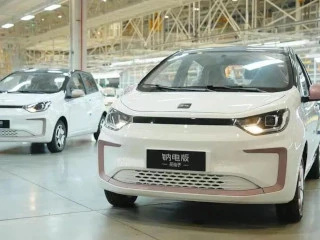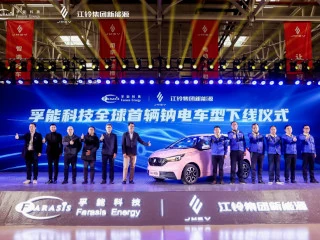This is a text with which we deviate from our main topic: imports from China, but since this topic is current and the news comes from China, we believe that it will be interesting for you to learn something new.
In the last two years, due to the shortage and the high prices of lithium enabled the flourishing of sodium-ion batteries, as a substitute for lithium batteries, and they quickly gained their popularity.
2023. the year the industry calls "the year of the sodium ion battery", where companies involved in the development of sodium ion batteries often received funding for the development of this new type of battery. Apart from them, companies that are dominantly involved in lithium batteries and car manufacturing have started to invest in sodium-ion batteries.
Development of sodium-ion battery application
In February 2023, Zhongke Hainan and Sihao New Energy jointly presented the first prototype of a sodium-ion vehicle.
In March, Yadi showed a bicycle with a sodium-ion battery.
In April, CATL announced that the first application of their sodium-ion battery will be in a Chery car model.
At the end of the year, sodium-ion batteries were finally introduced into mass-produced cars.
In less than a year, sodium-ion batteries batteries have gone from testing and verification to the first mass production, showing an impressive pace of development.
At the end of 2023, on December 27 and 28 to be exact, two car models with sodium-ion batteries appeared.
The first sodium-ion battery-powered electric vehicle rolled off the assembly line in China on December 27, 2023. The vehicle is made by Yiwei, a brand of the JAC Group, and uses batteries from Hina Battery. Hina said this vehicle is equipped with cylindrical sodium ion cells that can support a driving range of 252 kilometers. The car will begin shipping in January 2024. Hina said her sodium batteries have been applied to electric bicycles and power plants for energy storage.
On December 28th, Funeng Technology in cooperation with Jiangling Group New Energy Vehicles, presented its first A00 class pure electric vehicle model equipped with sodium ion battery, which officially rolled off the production line. This is their first mass-produced car with a sodium-ion battery, while mass deliveries of the car are planned for January 2024.
The new car has a range of up to 251 km, making it the first micro electric vehicle with a sodium ion battery developed through the cooperation between Funeng Technology and Jiangling Group's new energy vehicle division.
Chinese newspaper The Paper reported that rising lithium prices in 2022 have prompted leading battery companies such as CATL and Eve Energy to accelerate their sodium-ion battery technology. According to an announcement by China's Ministry of Industry and Information Technology in June 2023, Chery Automobile plans to launch an EV with CATL's sodium-ion batteries.
Also, BYD, the giant of the Chinese auto industry, is testing its prototype vehicle with a new type of battery.
Meet sodium-ion batteries

Yiwei EV. Credit: JAC
Sodium and lithium belong to the same group of chemical elements, which means that they have similar physical and chemical properties and show similar behavior during battery operation.
Research and development of lithium-ion and sodium-ion batteries began at about the same time, in the late 1970s. However, technical obstacles and differences in performance at the time meant that sodium-ion battery technology remained in the laboratory for a long time and was not widely applied.
Starting in 2021, the price of lithium has risen significantly, so sodium-ion batteries, which have been waiting for thirty years, have come to the fore.
In conditions of constant growth in lithium prices, sodium-ion batteries are becoming an alternative solution in some areas of application.
In addition, compared to rare lithium ores, sodium reserves in the world are significantly larger.
China also has a significant advantage in sodium reserves, which account for about 22% of the world's total reserves.
Lithium resources are scarce, making up only 0.0065% of the Earth's crust, with an uneven distribution. Over 70% of lithium resources are concentrated in Chile, Australia and Argentina. China is estimated to have 7% of the world's lithium resources, mostly in the difficult locations of Tibet. Therefore, at the fourth session of the 13th National Committee of the Communist Party of the Soviet Union, the Ministry of Science and technologies and the Ministry of Finance gave guidelines in the development of new technologies.
Given China's high dependence on foreign sources of lithium, the development of sodium-ion batteries becomes necessary from a strategic point of view, in order to avoid potential dependence that could be controlled.
Companies such as CATL, EVE Energy, PENGHUAI Energy, HUAYANG Corporation, RONBAY Technology and other battery manufacturers have announced plans to produce sodium ion batteries and electrodes, expressing their commitment to the industrial development of sodium ion batteries.
When it comes to car manufacturers, domestic brands such as BYD, JAC, JMC, Chery, as well as many foreign manufacturers, are announcing the introduction of sodium-ion batteries to the passenger vehicle market.
According to statistics from the Gao Gong Research Institute, the number of companies that are part of the sodium-ion battery production chain now exceeds 100. From 2023 to 2025, the effective capacity of sodium-ion battery companies is expected to reach 19 GWh, 25 GWh, or 60 GWh.
In terms of production processes, sodium-ion batteries can be compatible with equipment and processes for the production of lithium-ion batteries, which also allows manufacturers of lithium-ion batteries to quickly switch production capacity by redirecting production lines to these batteries.
Performance comparison
From the perspective of battery performance itself, the safety and stability of sodium-ion batteries is their outstanding advantage. Especially in terms of performance at high and low temperatures. Sodium-ion batteries have a wider operating temperature range and can normally operate in a temperature range of -40°C to 80°C. The capacity retention rate is close to 90% at temperatures of -20°C, which is far better than lithium batteries. We believe you have seen a robot graveyard due to the cold temperatures in America.
At the same time, the internal resistance of sodium ion batteries is higher than that of lithium ion batteries. In the event of a short circuit, the instantaneous heat generation is less, the temperature rise is less, the heat escape temperature is higher than that of lithium-ion batteries, and it is less likely to cause accidents such as fire and explosion.
However, sodium ion batteries still have a fundamental drawback, which is energy density. Due to the larger radius of the sodium-ion ion compared to the lithium-ion ion, the energy density of sodium-ion batteries is relatively lower for the same mass, which means that sodium-ion batteries have a lower energy density compared to lithium batteries. It also limits the use of sodium batteries.
Today, sodium-ion batteries have about half the energy density of lithium-ion batteries. Which means less range, which is the opposite of what most people want in their electric cars.
For comparison, the current EV3 that uses a lithium battery has a built-in 31kWh battery and a range of 301 km. The same sodium battery vehicle will have a 21.4kWh battery and have a range of 251 km. It will be priced at RMB 58,800 ($8,306), which is about $500 less than the EV3 with a lithium battery. Is that enough of a difference to compensate for the loss of about 50 km of range?
We don't know, but we do know that this technology is in development and will become more advanced and cheaper.
Two car models with sodium-ion batteries, which recently came off the production lines as the first in the world, are presented as models with low autonomy and intended for short trips.

Image credit: Farasis Energy via CnEVPost
According to available information, the sodium-ion model "HuaXianZi" electric vehicle, jointly developed by Zhongke Hainan and JAC Yttrium, has an autonomy of 252 kilometers.
The second model, the sodium-ion model - Jiangling Yizhi EV3 (Youth Edition), developed by Funeng Technology and Jiangling Group, has an autonomy of 251 kilometers.
"When sodium-ion battery technology advances and becomes mature, it will certainly take some of the lithium-ion battery market, for example in the micro-electric vehicle segment, and sodium will dominate in the future." - said Su Jianxun, founder and president of True Lithium Research, for YesAuto (the leading automotive internet platform in China).
In the two-wheeler and three-wheeler sectors, Su Jianxun believes that sodium-ion batteries will take some of the market share from lead-acid batteries because, at the same cost, sodium-ion batteries have a higher energy density than lead-acid batteries. "When sodium-ion batteries come to life, it will practically mean the end of batteries, of lead and acids." - says Su Jianxun.
In addition, sodium-ion batteries have their application in the field of energy storage.
According to Funeng Technology, the energy density of currently produced sodium ion batteries ranges from 140-160Wh/kg.
In terms of safety performance, the batteries have passed crash tests as well as multiple tests including overcharging, overdischarge, compression and water immersion, and the battery also meets the NO TP standard.
Regarding low temperature performance, the discharge capacity retention rate at -20℃ can reach over 91%. In terms of lifespan, it can meet the requirements of passenger vehicles.
According to the plans, Funeng Technology will launch the second generation of sodium-ion batteries in 2024, and bring the energy density to between 160-180Wh/kg.
By 2026, the energy density of new generation sodium-ion battery products will further reach 180-200Wh/kg, which will meet the needs of various applications.
Funeng Technology stated that sodium-ion batteries have superior low-temperature performance compared to current chemical systems, effectively solving the problem of limited range in new energy vehicles in low-temperature conditions.
In addition, safety, economic profitability, environmental protection as well as the fact that there is an abundance of salt are factors that make us hope that China will continue the development of sodium-ion batteries.
It is certain that in the near future, sodium ion batteries will become an important supplement to lithium batteries in situations where safety is essential, such as home energy storage and industrial energy storage.
Competition drives down prices
However, not everything is so great. As sodium ion battery development experienced its expansion, we witnessed in 2023 the price of lithium carbonate drop by more than 80% annually, which caused a sharp drop in the price of lithium ion cells, and this fluctuation is rarely seen in the mainstream market. goods.
After the drastic drop in the price of lithium carbonate, will sodium be forgotten?
If we say that the rise of sodium-ion batteries was fueled by a "lithium price frenzy", then the current drastic drop in lithium prices will certainly slow the momentum of sodium-ion batteries.
In January this year, according to data released by the Shanghai Steel Union, the average price of lithium carbonate for batteries was 101,000 yuan per ton. Last year at this time, the price of lithium carbonate for batteries was about 500,000 yuan per ton. Under conditions of overcapacity, the downward trend in lithium prices will continue until a new balance between supply and demand is established.
Continued decline in lithium carbonate prices will undoubtedly represent a blow to the newly popular sodium-ion batteries.
In the past two years, when lithium prices have been high, sodium-ion batteries have quickly become a "substitute" as a new technology that can ease "lithium price anxiety." However, when lithium prices have plummeted, the advantage of sodium-ion batteries is no longer so obvious. "Interest in sodium-ion batteries is noticeably decreasing this year, primarily because lithium prices have plummeted." - said one industry expert.
Battery prices today
As representatives of Bluesun solar systems we have hints that the prices of the panels that are offered now will most likely not go down significantly, but that the prices of the batteries will be significantly lower and very soon. It remains for us to see what awaits us in the future.
One thing is certain, China as a country has decided for the strategic development of a closed energy circle that consists of "energy production from renewable sources (solar panels, wind energy and are the world leaders in this technology) - UHV energy transmission (UHV refers to long-distance, ultra-large-scale power transmission technology) - energy storage (a part of which is the development of sodium batteries).
We can only hope that future electric vehicles will not be so expensive because salt as the main part of the battery is all around us and batteries make up about 40% of the price of an electric vehicle.
Source of information https://36kr.com/ , https://www.yesauto.com/ and https://cleantechnica.com/

